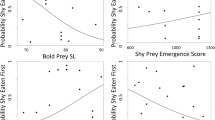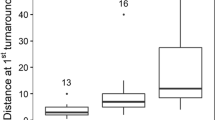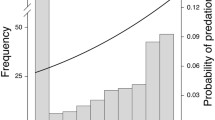Abstract
Consistent individual differences in behavioural responses to perceived predation risk may have extensive ecological and evolutionary implications. We studied the repeatability of boldness across time and its relation to resource holding potential in the noble crayfish, Astacus astacus L., using predator-naïve immature individuals. We followed individual’s shelter use both with and without exposure to the chemical and physical cues of predators, and with and without the presence of a conspecific. In addition, we examined if armament, i.e. relative chelae size, would be correlated with individual differences in behaviour. Individuals showed repeatable behaviours across time and context. Individuals that occupied the shelter in competitive dyadic tests also spent more time in the shelter during individual control observations, suggesting that boldness is a personality trait that does not necessarily relate positively to high resource holding potential in the noble crayfish. The relative size of chelae did not correlate with any of the measured behavioural variables. Our results suggest that boldness can be considered as individually consistent and ecologically important personality trait in the noble crayfish.



Similar content being viewed by others
References
Adriaenssens B, Johnsson JI (2009) Personality and life-history productivity: consistent or variable association? TREE 24:179–180. doi:10.1016/j.tree.2008.12.003
Ahvenharju T, Ruohonen K (2006) Unequal division of food resources suggests feeding hierarchy of signal crayfish (Pacifastacus leniusculus) juveniles. Aquaculture 259:181–189
Appelberg M, Söderbäck B, Odelström T (1993) Predator detection and perception of predation risk in the crayfish Astacus astacus L. Nord J Freshw Res 68:55–62
Bell AM (2007) Future directions in behavioural syndromes research. Proc R Soc Lond B 274:755–761. doi:10.1098/rspb.2006.0199
Bell AM, Hankison SJ, Laskowski KL (2009) The repeatability of behaviour: a meta-analysis. Anim Behav 77:771–783. doi:10.1016/j.anbehav.2008.12.022
Berglund A, Bisazza A, Pilastro A (1996) Armaments and ornaments: an evolutionary explanation of traits of dual utility. Biol J Linn Soc 58:385–399
Biro PA, Stamps JA (2008) Are animal personality traits linked to life-history productivity. TREE 23:361–368. doi:10.1016/j.tree.2008.04.003
Blake MA, Hart PJB (1993) The behavioural response of juvenile signal crayfish Pacifastacus leniusculus to stimuli from perch and eels. Freshw Biol 29:89–97
Brown C, Burgess F, Braithwaite VA (2007) Heritable and experiential effects on boldness in a tropical poeciliid. Behav Ecol Sociobiol 62:237–243
Bywater CL, Angilletta MJ, Wilson RS (2008) Weapon size is a reliable indicator of strength and social dominance in female slender crayfish (Cherax dispar). Funct Ecol 22:311–316. doi:10.1111/j.1365-2435.2007.01379.x
Carvalho LN, Del-Claro K (2004) Effects of predation pressure on the feeding behaviour of the serpa tetra Hyphessobrycon eques (Ostrariophysi, Characidae). Acta Ethol 7:89–93. doi:10.1007/s10211-004-0093-1
Dall SRX, Houston AI, McNamara JM (2004) The behavioural ecology of personality: consistent individual differences from an adaptive perspective. Ecol Lett 7:734–739. doi:10.1111/j.1461-0248.2004.00618.x
Dingemanse NJ, Van der Plas F, Wright J, Reale D, Schrama M, Roff DA, Van der Zee E, Barber I (2009) Individual experience and evolutionary history of predation affect expression of heritable variation in fish personality and morphology. Proc R Soc Lond B Biol Sci 276:1285–1293
Figler MH, Cheverton HM, Blank GS (1999) Shelter competition in juvenile red swamp crayfish Procambarus clarkii: the influences of sex differences, relative size, and prior residence. Aquaculture 178:63–75
Garvey JE, Stein RA, Thomas HM (1994) Assessing how fish predation and interspecific prey competition influence a crayfish assemblage. Ecology 75:532–547
Hirvonen H, Holopainen S, Lempiäinen N, Selin M, Tulonen J (2007) Sniffing the trade-off: effects of eel odours on nocturnal foraging activity of native and introduced crayfish juveniles. Mar Freshw Behav Physiol 40:213–218
Huntingford FA (1976) The relationship between anti-predator behaviour and aggression among conspecifics in the three-spined stickleback, Gasterosteus aculeatus. Anim Behav 24:245–260
Ioannou CC, Payne M, Krause J (2008) Ecological consequences of the bold–shy continuum: the effect of predator boldness on prey risk. Oecologia 157:177–182
Kats LB, Dill LM (1998) The scent of death: chemosensory assessment of predation risk by prey animals. Ecoscience 5:361–394
Kortet R, Hedrick A (2007) A behavioural syndrome in the field cricket Gryllus integer: intrasexual aggression is correlated with activity in a novel environment. Biol J Linn Soc 91:475–482. doi:10.1111/j.1095-8312.2007.00812.x
Krebs CJ (1999) Ecological methodology, 2nd edn. Benjamin/Cummings, Menlo Park
Lima SL, Bednekoff PA (1999) Temporal variation in danger drives antipredatory behavior: the predation risk allocation hypothesis. Am Nat 153:649–659
Lima SL, Dill LM (1990) Behavioral decisions made under the risk of predation: a review and prospectus. Can J Zool 68:619–640
Luttbeg B, Sih A (2010) Risk, resources and state-dependent adaptive behavioral syndromes. Phil Trans R Soc Lond B (in press). doi:10.1098/rstb.2010.0207
Nyström P (2005) Non-lethal predator effects on the performance of a native and an exotic crayfish species. Freshw Biol 50:1938–1949
Pintor LM, Sih A, Bauer ML (2008) Differences in aggression, activity and boldness between native and introduced populations of an invasive crayfish. Oikos 117:1629–1636. doi:10.1111/j.1600-0706.2008.16578.x
Preisser EL, Bolnick DI, Benard MF (2005) Scared to death? The effects of intimidation and consumption in predator–prey interactions. Ecology 86:501–509
Ranta E, Lindström K (1993) Body size and shelter possession in mature signal crayfish, Pacifastacus leniusculus. Ann Zool Fenn 30:125–132
Réale D, Reader SM, Sol D, McDougall PT, Dingemanse NJ (2007) Integrating animal temperament within ecology and evolution. Biol Rev 82:291–318. doi:10.1111/j.1469-185X.2007.00010.x
Riechert SE, Hedrick AV (1993) A test for correlations among fitness-linked behavioural traits in the spider Agelenopsis aperta (Araneae, Agelenidae). Anim Behav 46:669–675
Riesch R, Duwe V, Herrmann N, Padur L, Ramm A, Scharnweber K, Schulte M, Schulz-Mirbach T, Ziege M, Plath M (2009) Variation along the shy–bold continuum in extremophile fishes (Poecilia mexicana, Poecilia sulphuraria). Behav Ecol Sociobiol 63:1515–1526
Rutherford PL, Dunham DW, Allison V (1995) Winning agonistic encounters by male crayfish Orconectes rusticus (Girard) (Decapoda, Cambaridae): chela size matters but chela symmetry does not. Crustaceana 68:526–529
Schroeder L, Huber R (2001) Fight strategies differ with size and allometric growth of claws in crayfish, Orconectes rusticus. Behaviour 138:1437–1449
Sih A, Bell AM (2008) Insights for behavioral ecology from behavioral syndromes. Adv Study Behav 38:227–281
Sih A, McCarthy TM (2002) Prey responses to pulses of risk and safety: testing the risk allocation hypothesis. Anim Behav 63:437–443. doi:10.1006/anbe.2001.1921
Sih A, Bell AM, Johnson JC, Ziemba RE (2004) Behavioral syndromes: an integrative overview. Quart Rev Biol 79:241–277
Sinn DL, Apiolaza LA, Moltschaniwskyj NA (2006) Heritability and fitness-related consequences of squid personality traits. J Evol Biol 19:1437–1447
Snedden WA (1990) Determinants of male mating success in the temperate crayfish Orconectes rusticus: chela size and sperm competition. Behaviour 115:100–113
Söderbäck B (1992) Predator avoidance and vulnerability of two co-occurring crayfish species, Astacus astacus (L.) and Pacifastacus leniusculus (Dana). Ann Zool Fenn 29:253–259
Stamps JA (2007) Growth–mortality tradeoffs and ‘personality traits’ in animals. Ecol Lett 10:355–363. doi:10.1111/j.1461-0248.2007.01034.x
Stamps J, Groothuis TGG (2010) The development of animal personality: relevance, concepts and perspectives. Biol Rev 85:301–325. doi:10.1111/j.1469-185X.2009.00103.x
Stein RA, Magnuson JJ (1976) Behavioral response of crayfish to a fish predator. Ecology 57:751–761
Usio N, Konish M, Nakano S (2001) Species displacement between an introduced and a ‘vulnerable’ crayfish: the role of aggressive interactions and shelter competition. Biol Invasions 3:179–185
Wilson ADM, McLaughlin RL (2007) Behavioural syndromes in brook charr, Salvelinus fontinalis: prey-search in the field corresponds with space use in novel laboratory situations. Anim Behav 74:689–698. doi:10.1016/j.anbehav.2007.01.009
Acknowledgements
This research has been supported by the Academy of Finland (project #127398) and by the Emil Aaltonen Foundation. We thank the staff of the Experimental Unit of the Department of Biology, University of Oulu for the maintenance of the crayfish and help in the practical execution of the experimental procedures. We thank Aki Puhka for his help in the experiments and two anonymous referees for the very valuable comments on the manuscript. We also gratefully acknowledge Nick DiRienzo for his valuable linguistic revision of the manuscript. The perch in this experiment were held in laboratory conditions with the permission ESLH-2009-06035/Ym-23 from ELLA (Finnish board for the use of animals in experiments).
Author information
Authors and Affiliations
Corresponding author
Rights and permissions
About this article
Cite this article
Vainikka, A., Rantala, M.J., Niemelä, P. et al. Boldness as a consistent personality trait in the noble crayfish, Astacus astacus . acta ethol 14, 17–25 (2011). https://doi.org/10.1007/s10211-010-0086-1
Received:
Revised:
Accepted:
Published:
Issue Date:
DOI: https://doi.org/10.1007/s10211-010-0086-1




